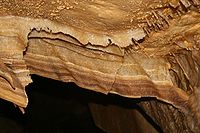
Caverns of Sonora
Encyclopedia

National Natural Landmark
The National Natural Landmark program recognizes and encourages the conservation of outstanding examples of the natural history of the United States. It is the only natural areas program of national scope that identifies and recognizes the best examples of biological and geological features in...
, is a unique cave
Cave
A cave or cavern is a natural underground space large enough for a human to enter. The term applies to natural cavities some part of which is in total darkness. The word cave also includes smaller spaces like rock shelters, sea caves, and grottos.Speleology is the science of exploration and study...
located 8 miles (12.9 km) west of the small city of Sonora
Sonora, Texas
Sonora is the county seat of Sutton County, Texas, United States. The population was 2,924 at the 2000 census.Former State Senator and Lieutenant Governor Bill Ratliff of Mount Pleasant was reared in Sonora and graduated from high school there.-Geography and climate:Sonora is located at ...
, the seat of Sutton County, Texas
Texas
Texas is the second largest U.S. state by both area and population, and the largest state by area in the contiguous United States.The name, based on the Caddo word "Tejas" meaning "friends" or "allies", was applied by the Spanish to the Caddo themselves and to the region of their settlement in...
. It is a world-class cave because of its stunning array of calcite
Calcite
Calcite is a carbonate mineral and the most stable polymorph of calcium carbonate . The other polymorphs are the minerals aragonite and vaterite. Aragonite will change to calcite at 380-470°C, and vaterite is even less stable.-Properties:...
crystal formations, especially helictite
Helictite
A helictite is a speleothem found in limestone caves that changes its axis from the vertical at one or more stages during its growth. They have a curving or angular form that looks as if they were grown in zero gravity...
s. These helictites are found in extreme abundance, often with a rare purity and complexity. One formation is so densely packed with them it has been dubbed the "Snake pit". The founder of the National Speleological Society
National Speleological Society
The National Speleological Society is an organization formed in 1941 to advance the exploration, conservation, study, and understanding of caves in the United States. Originally located in Washington D.C., its current offices are in Huntsville, Alabama...
, Bill Stephenson, said of the cave after his first visit: "This is the most indescribably beautiful cave in the world, its beauty cannot be exaggerated, not even by a Texan."
History

The cave has been operated commercially by the Mayfield family since July 16, 1960. Today, 2 miles (3.2 km) of trail have been developed out of the 7 miles (11.3 km) of explored cave. The development of the trails was done by Jack Burch, starting in 1959 and completing in 1979. Burch revolutionized cavern development worldwide with his "conservation through commercialization" approach to the project.
The cave is formed in 100 million-year-old (Cretaceous
Cretaceous
The Cretaceous , derived from the Latin "creta" , usually abbreviated K for its German translation Kreide , is a geologic period and system from circa to million years ago. In the geologic timescale, the Cretaceous follows the Jurassic period and is followed by the Paleogene period of the...
) Segovia limestone
Limestone
Limestone is a sedimentary rock composed largely of the minerals calcite and aragonite, which are different crystal forms of calcium carbonate . Many limestones are composed from skeletal fragments of marine organisms such as coral or foraminifera....
, of the Edward Limestone Group. The formation of the cave itself probably occurred between 1.5 to 5 million years ago. The cave is formed primarily along a fault. This fault allowed gases to rise up from depths of around 1.5 miles (2.4 km) to then depths of about 300 feet (91.4 m). At this depth the gases mixed with water in the aquifer
Aquifer
An aquifer is a wet underground layer of water-bearing permeable rock or unconsolidated materials from which groundwater can be usefully extracted using a water well. The study of water flow in aquifers and the characterization of aquifers is called hydrogeology...
. The resulting highly acidic water dissolved out the limestone, forming the cave. Between 1–3 million years ago, the water drained form the cave. The famous mineral formations, known as speleothem
Speleothem
A speleothem , commonly known as a cave formation, is a secondary mineral deposit formed in a cave. Speleothems are typically formed in limestone or dolostone solutional caves.-Origin and composition:...
s, all formed after the water drained from the cave. The cave's most famous formation is the butterfly http://www.cavernsofsonora.com/images/img03.jpg. It is the only known formation like it in the world. It is formed by two fish tail helictite growths that share the same attachment point of the cave wall.
On November 21, 2006, the butterfly formation was vandalized by a member of a tour group. Specifically, 60% of the top right tip of the wing was broken off of the formation. There is a $20,000 reward for any information that leads to the recovery of the missing piece. Since the butterfly is active (still growing), the formation can still be repaired if the piece is recovered soon.
External links
- Caverns of Sonora.com
- Low Res picture of the butterfly formation
- High Res picture of the butterfly formation
- Before and after - the broken butterfly formation
- Mysteries at the Caverns of Sonora San Angelo LIVE!
30.554999°N 100.812274°W

